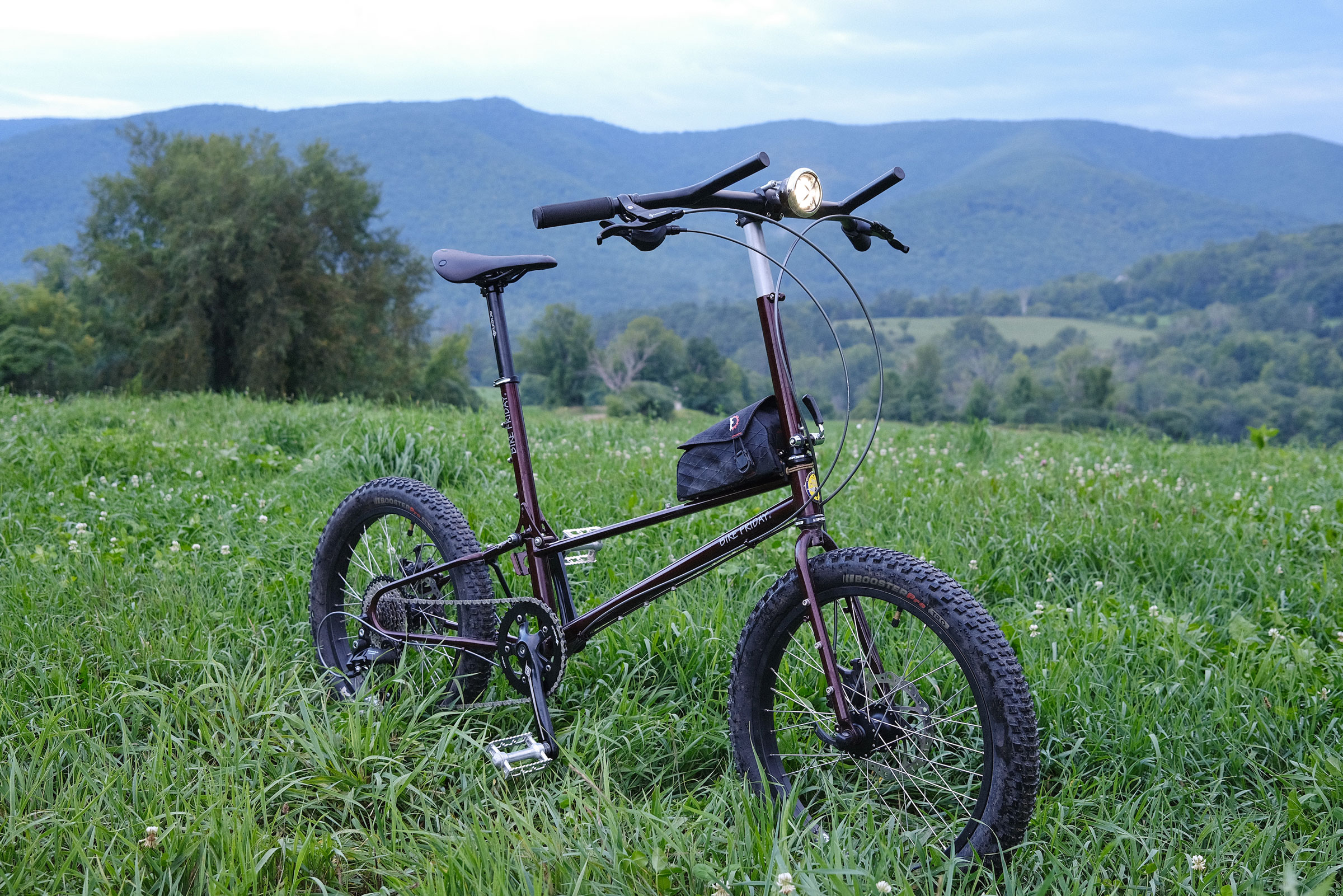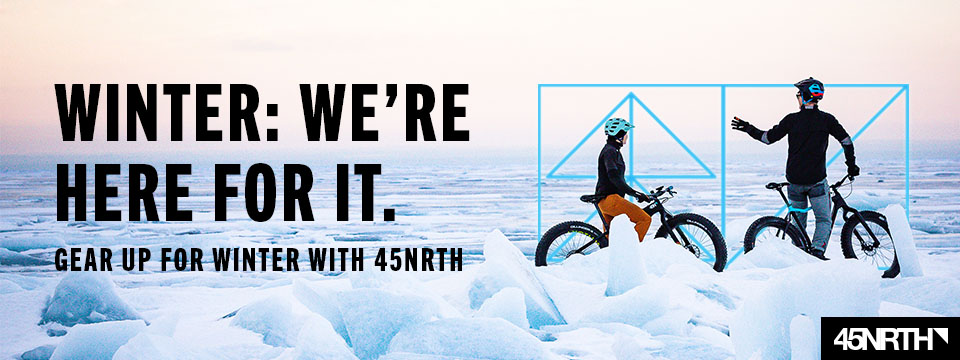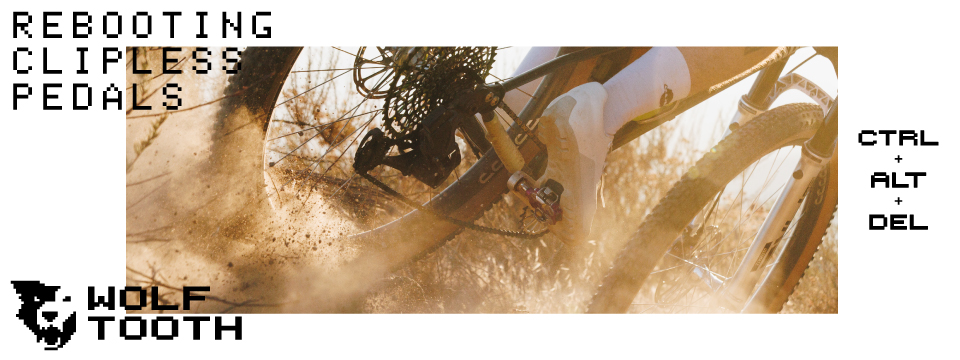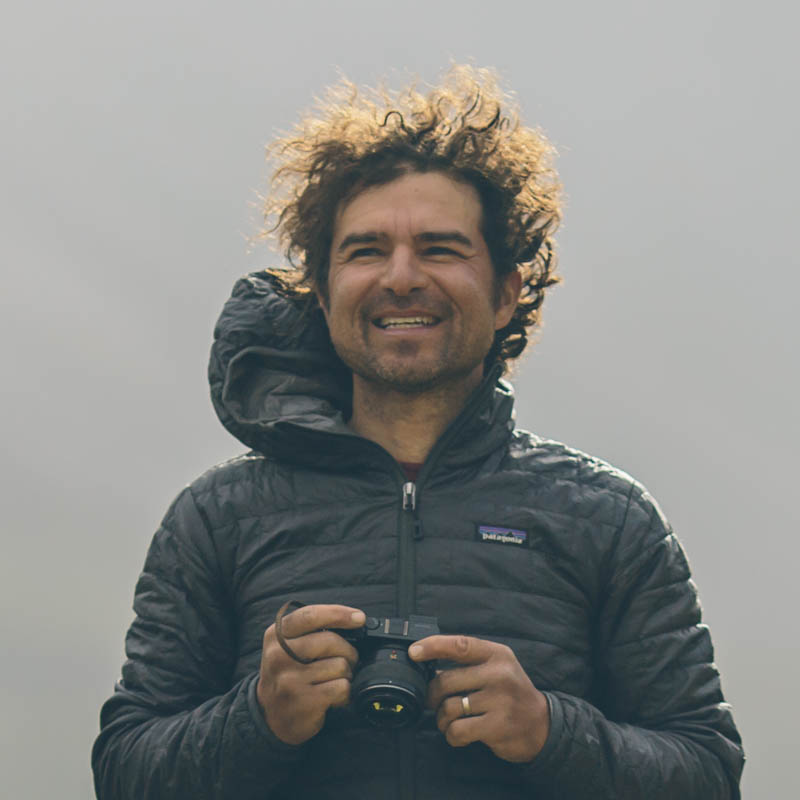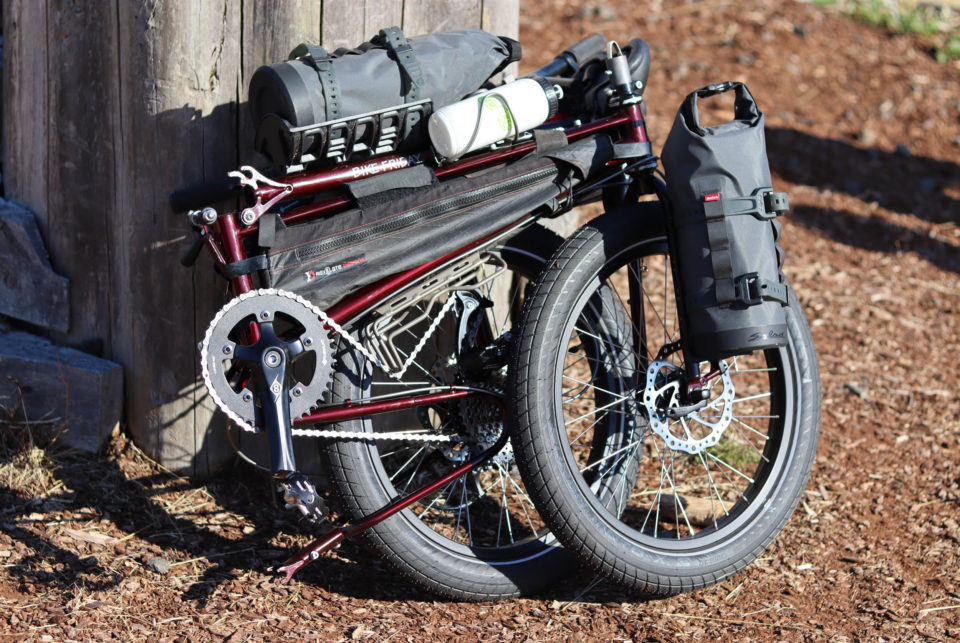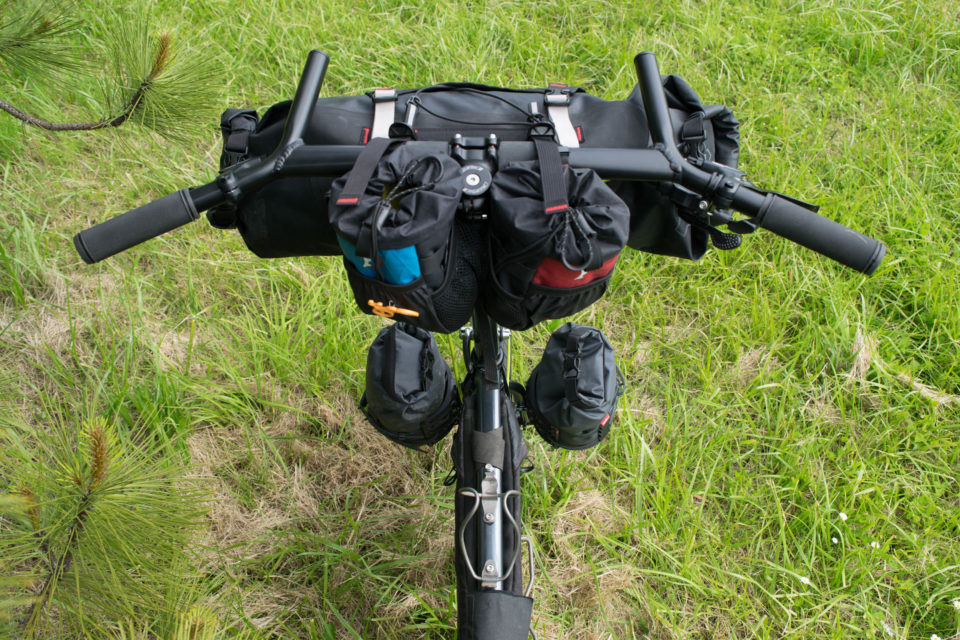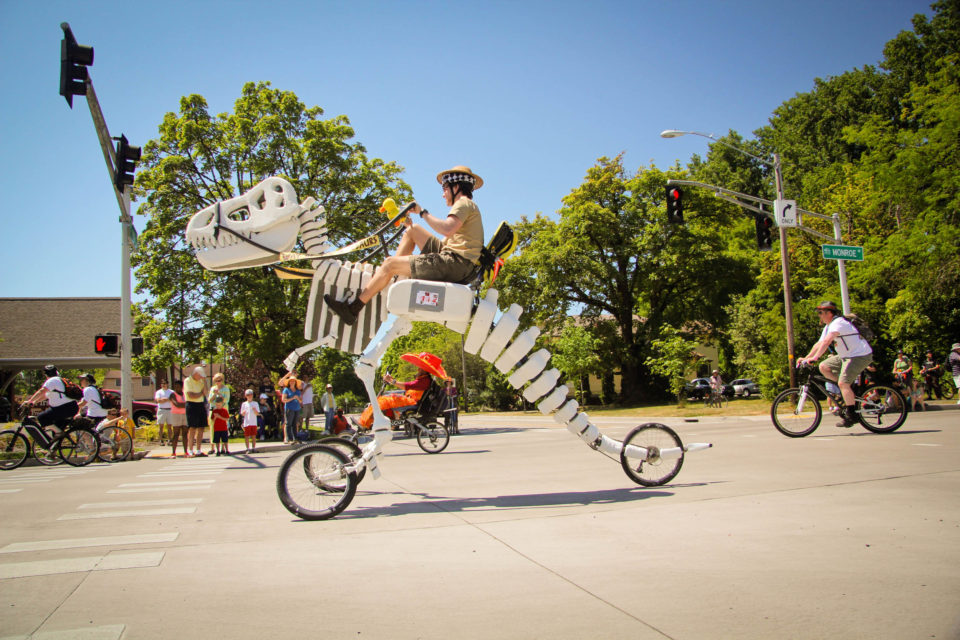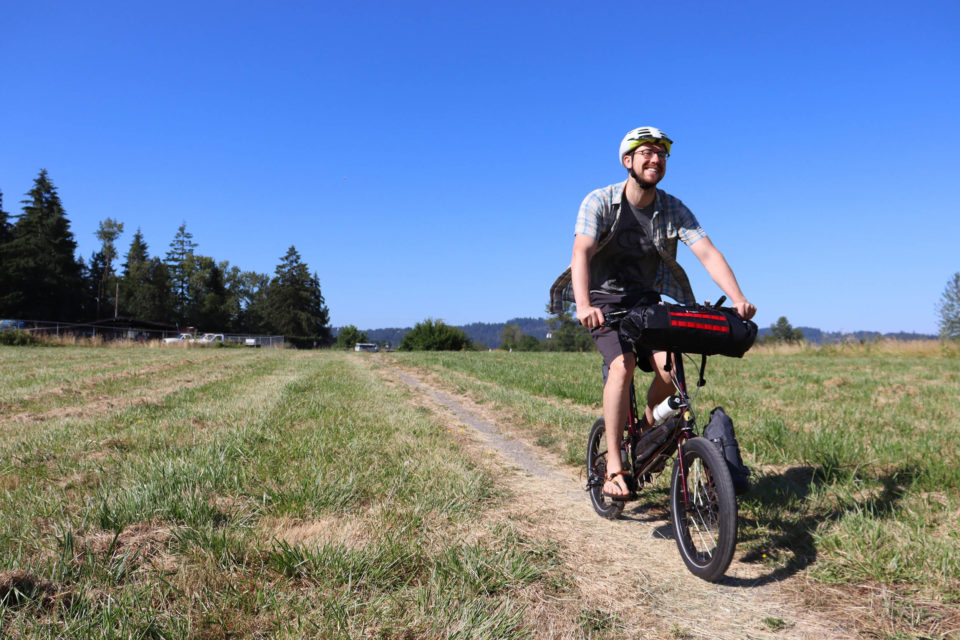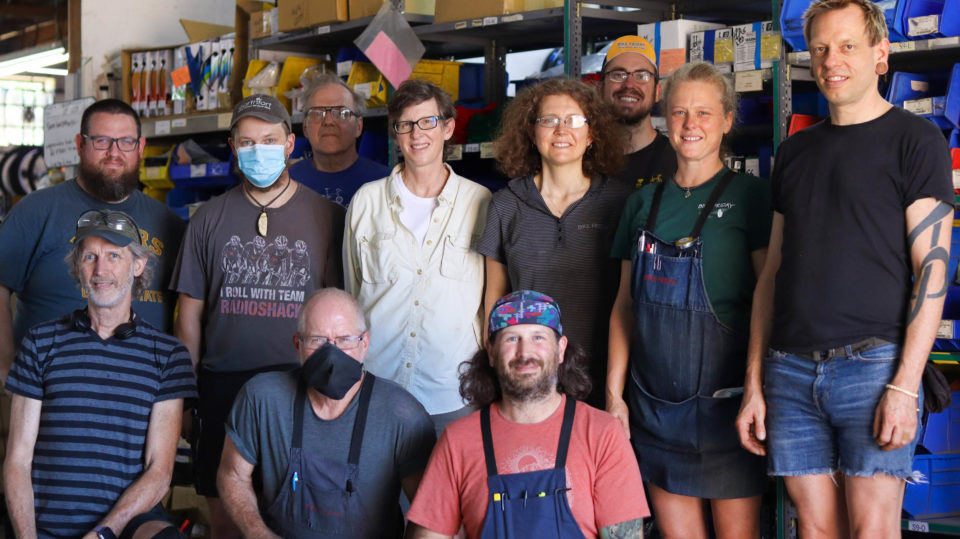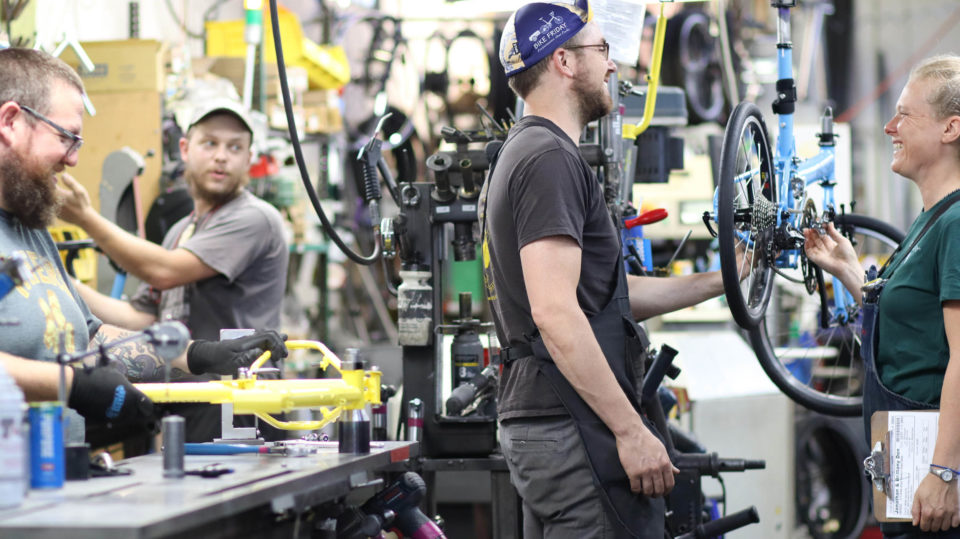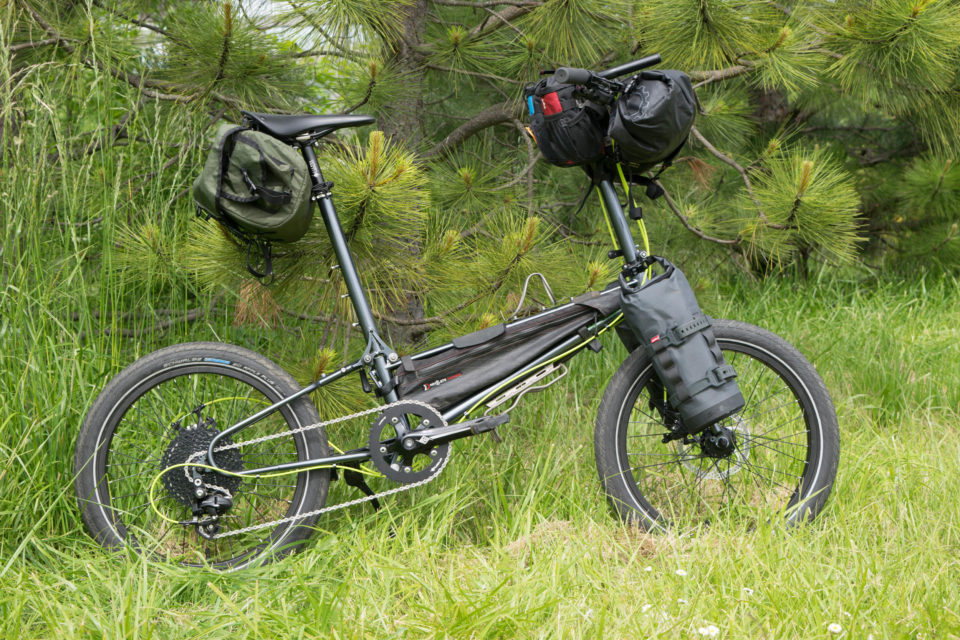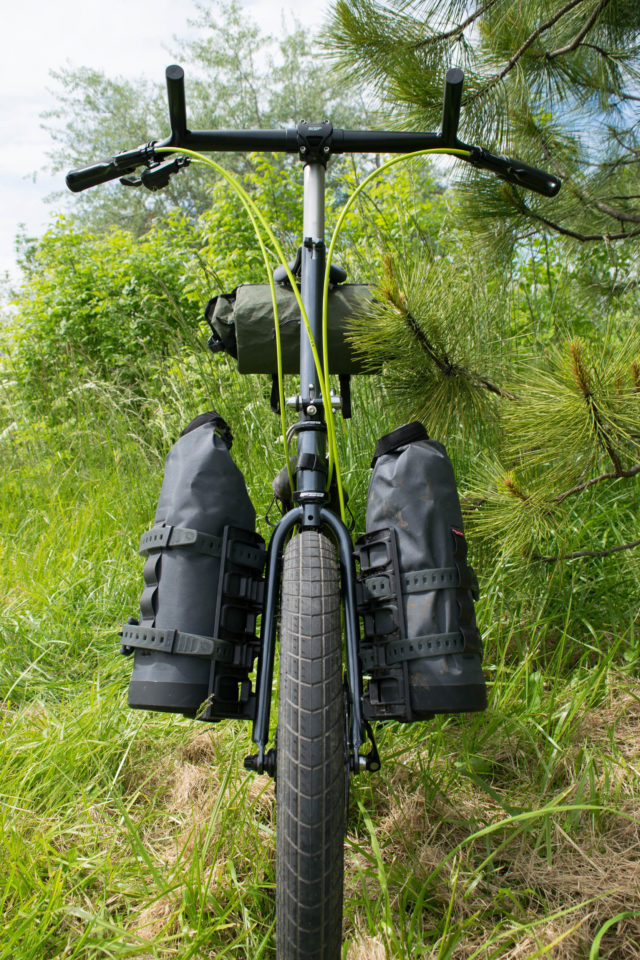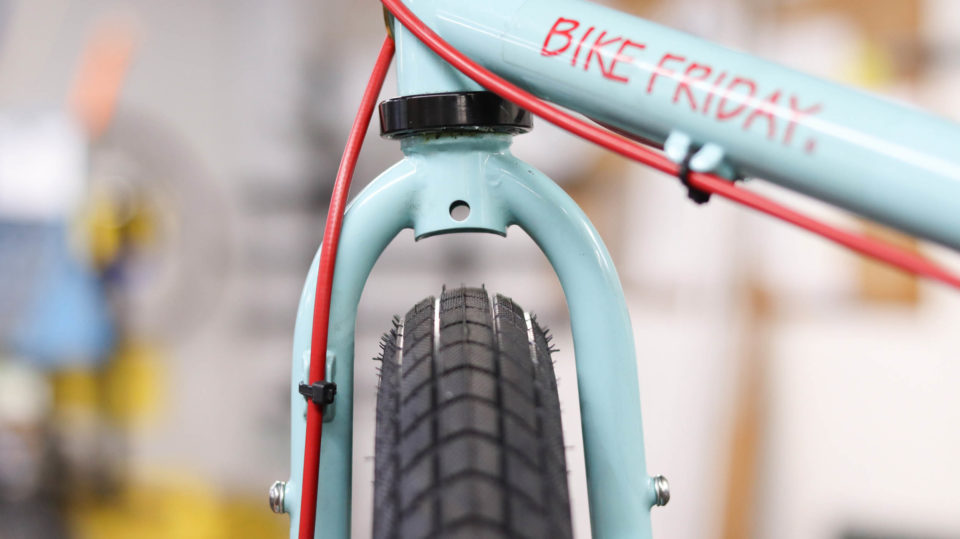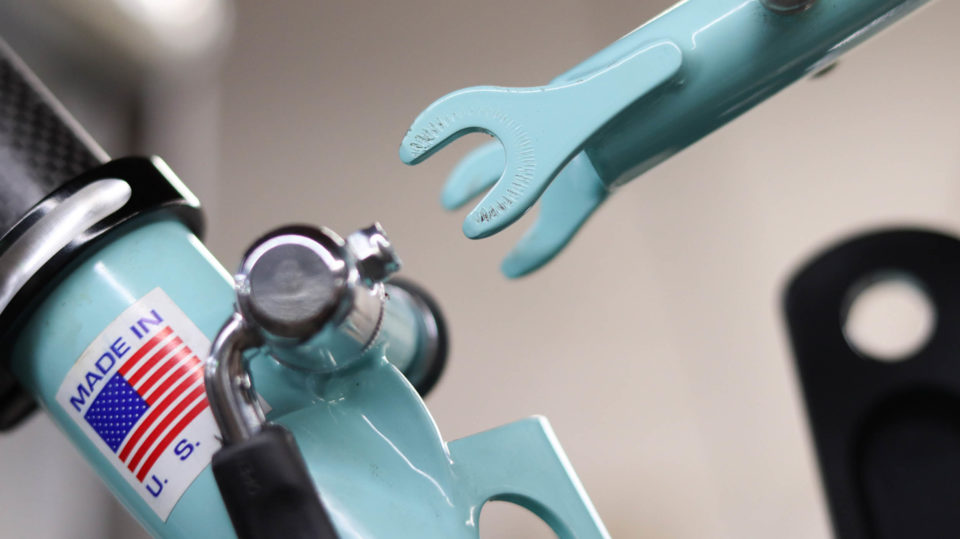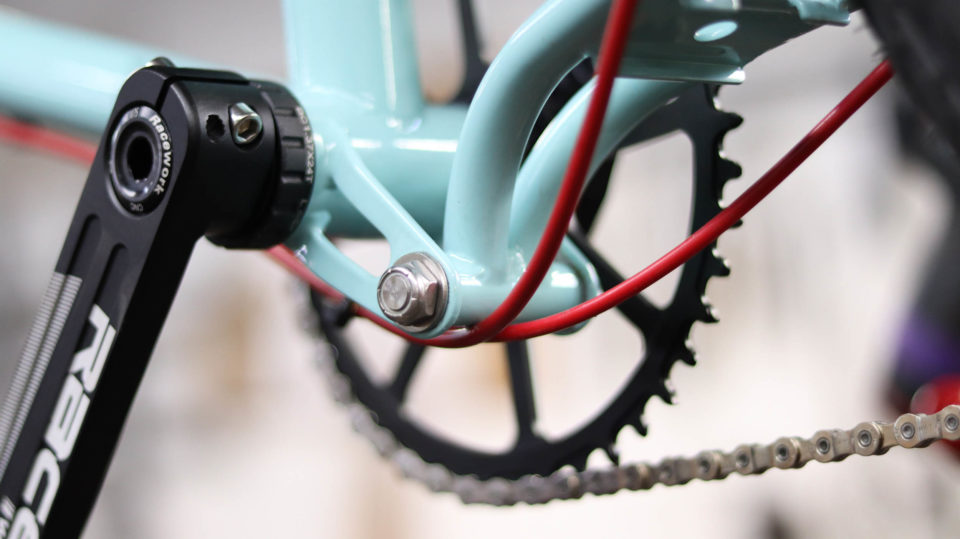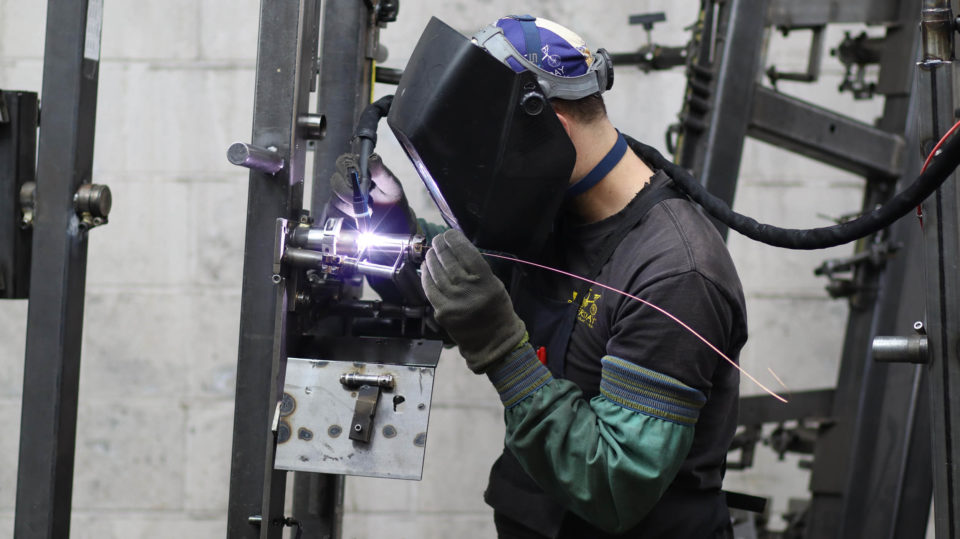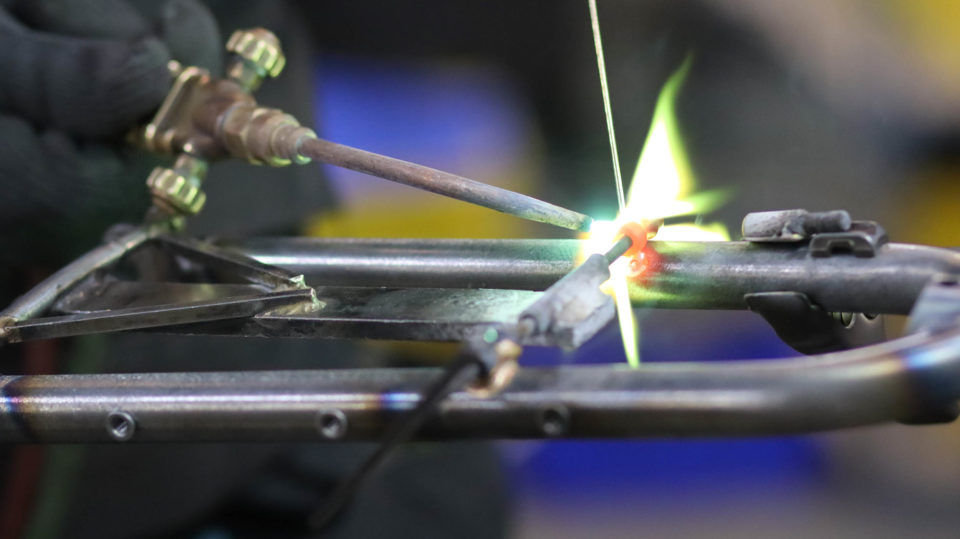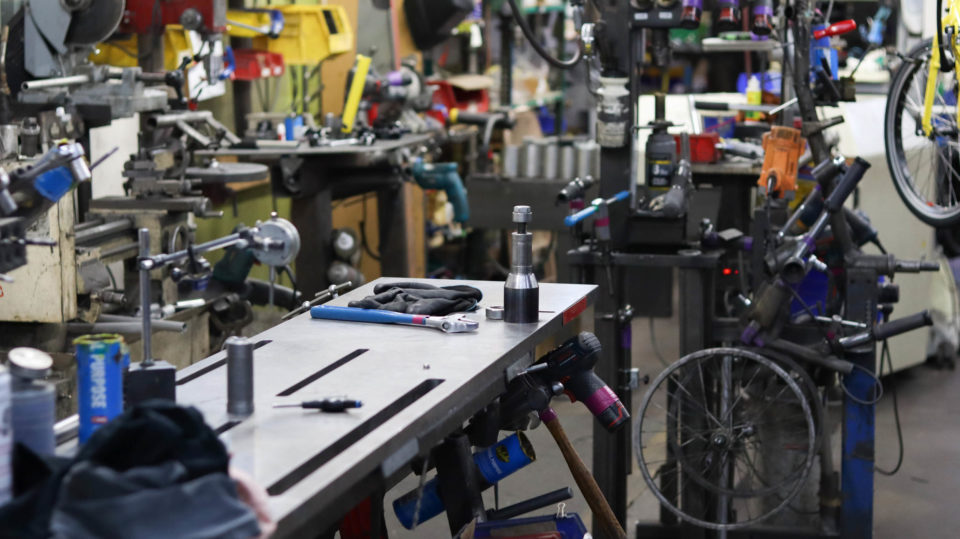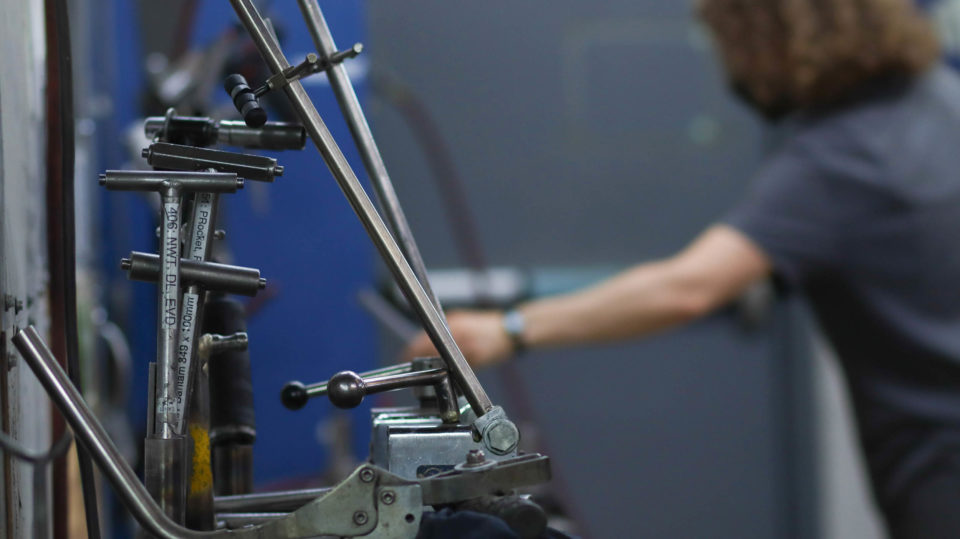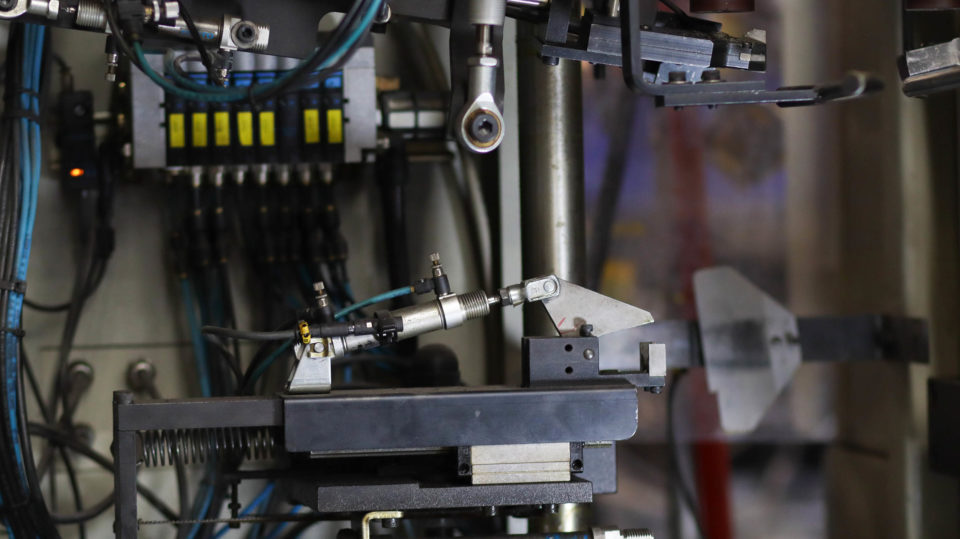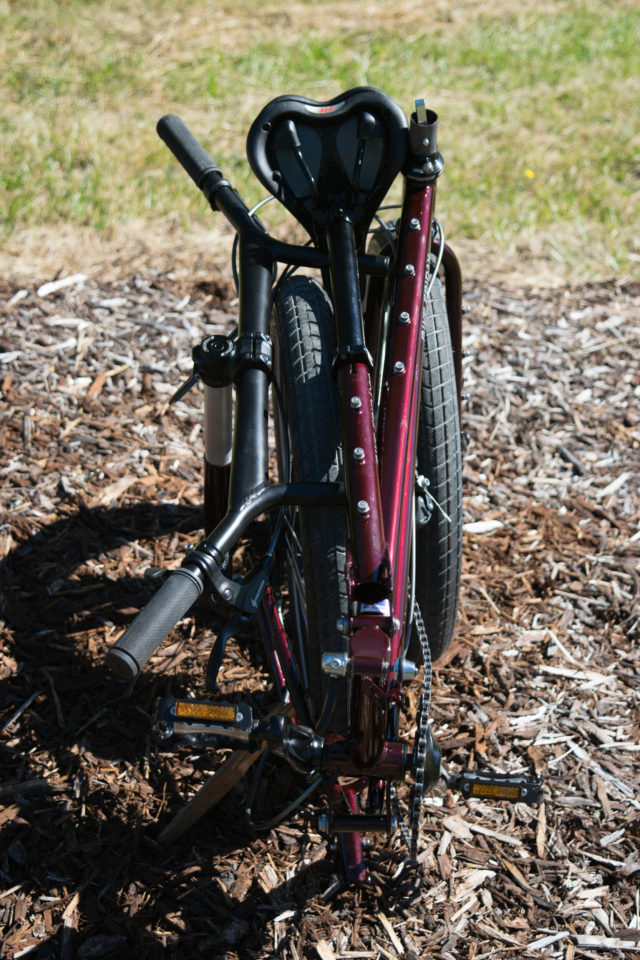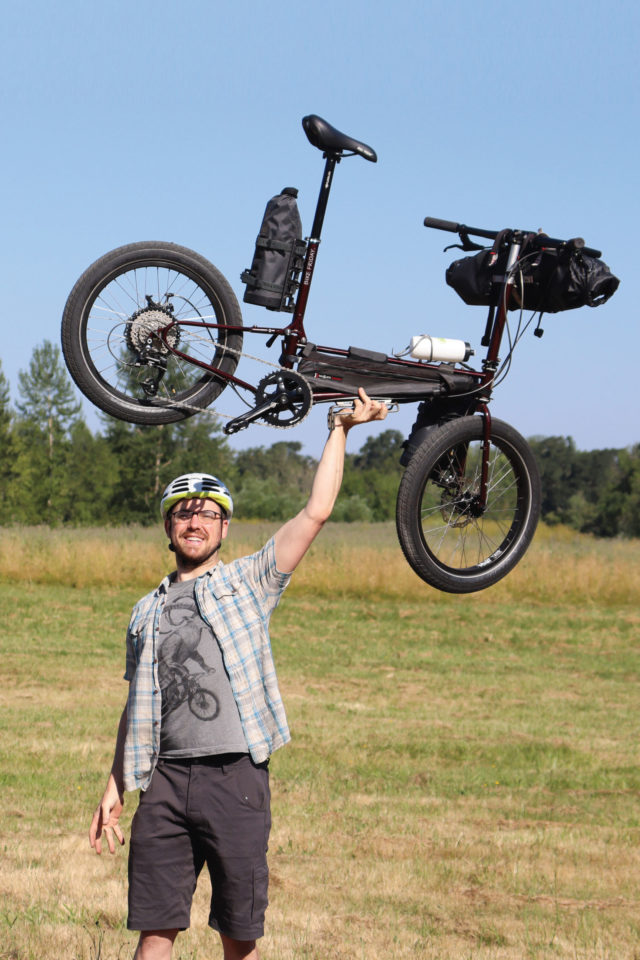Introducing the Bike Friday All-Packa: Behind the Scenes with Willie Hatfield
Bike Friday recently unveiled their new bike designed for gravel riding and bikepacking on everything from dirt roads to chunky doubletrack to flowy singletrack. Like most Bike Fridays, the All-Packa has 20” wheels and folds into a standard suitcase for travel. It also features clearance for 2.4” tires, a newly developed alt-bar, and loads of mounts and space for bags. Read more about it and find an interview with the designer here…
PUBLISHED Aug 15, 2022
Photos by Casey Wheeler and Willie Hatfield
My cards on the table: I love Bike Fridays. I got my first one over 20 years ago for tours in faraway places. The multi-modal travel possibilities were transformative. I took it on buses and trains and threw it in the back of kind strangers’ cars when I got in over my head. It was a compact package to take up the stairs at a hostel, or I could keep an eye on it stashed in the corner of a restaurant. Many folders and mini velos ride terrifically—the Bike Fridays are the best in my experience—and they are functional and fun. Margaret and I still routinely take our Bike Fridays on vacations, pack them into the trunk of tiny rental cars, and unfold them in mere minutes to explore cities and the countryside.
When Willie Hatfield at Bike Friday reached out to ask whether I’d be interested in testing their new model built specifically for bikepacking, I was enthusiastic and intrigued. I thought I had a pretty good idea of what to expect, but the truth is that I had no idea just how great a folder could be. The All-Packa is astonishing. It’s stable, it’s much more precise than any little-wheel bike I’ve been on, it floats over chunky gravel and choppy doubletrack, and it’s an absolute blast to ride on singletrack.
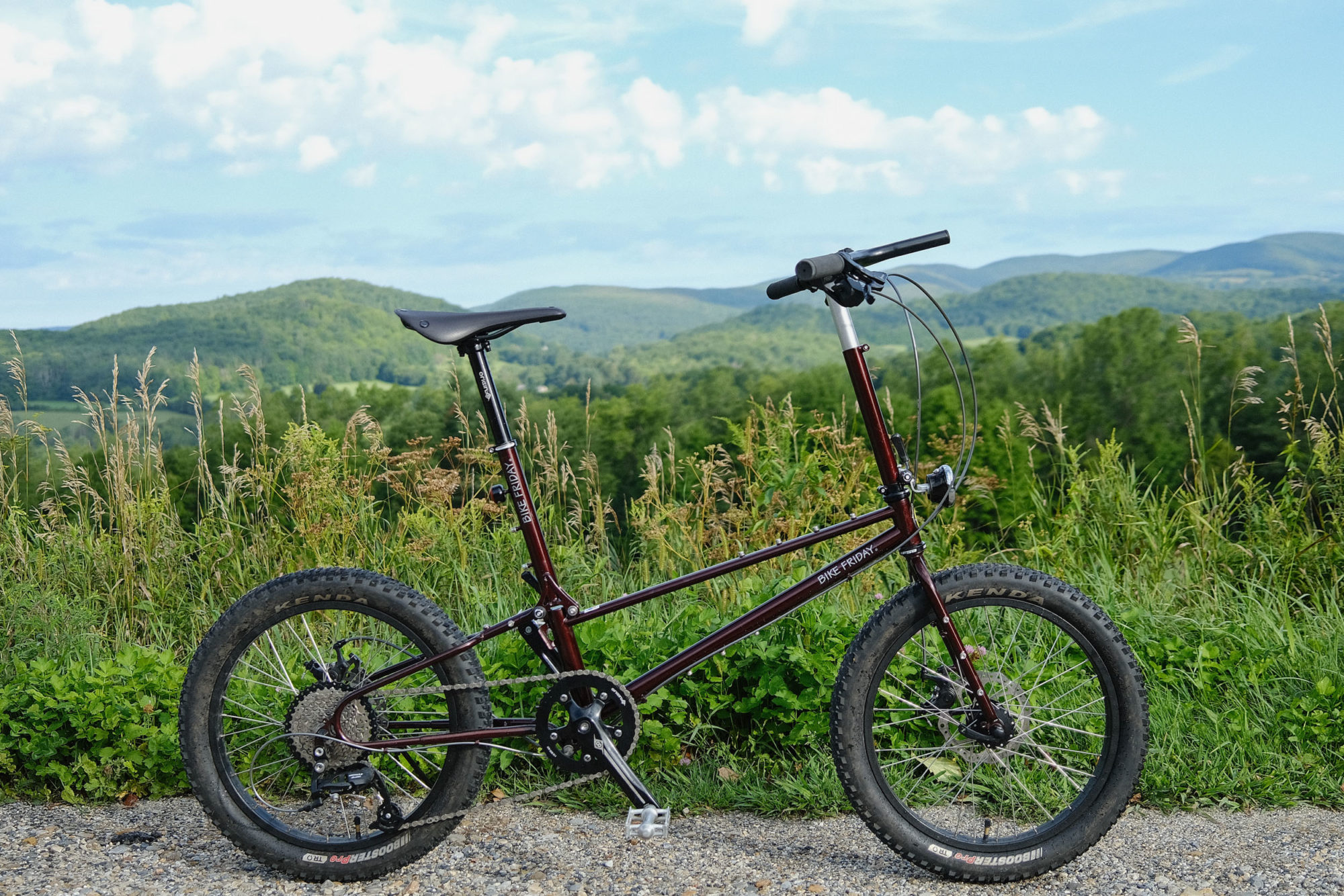
By now, I’ve done a dozen day rides and a few overnighters on a prototype, and can say with confidence that this thing rips and that I completely dig it. I’ll prepare a full review of the bike after I put it through a month of serious riding, and we also have frequent BIKEPACKING.com contributor Devin Cowens testing an All-Packa to report back on the experience of a smaller rider, for whom Bike Fridays are ideal (I’m 5’8”/173cm, Devin is 5’/152cm). In the meantime, we’re excited and thankful to have Willie give a behind-the-scenes look at the development of the All-Packa. Let’s start with an introduction.
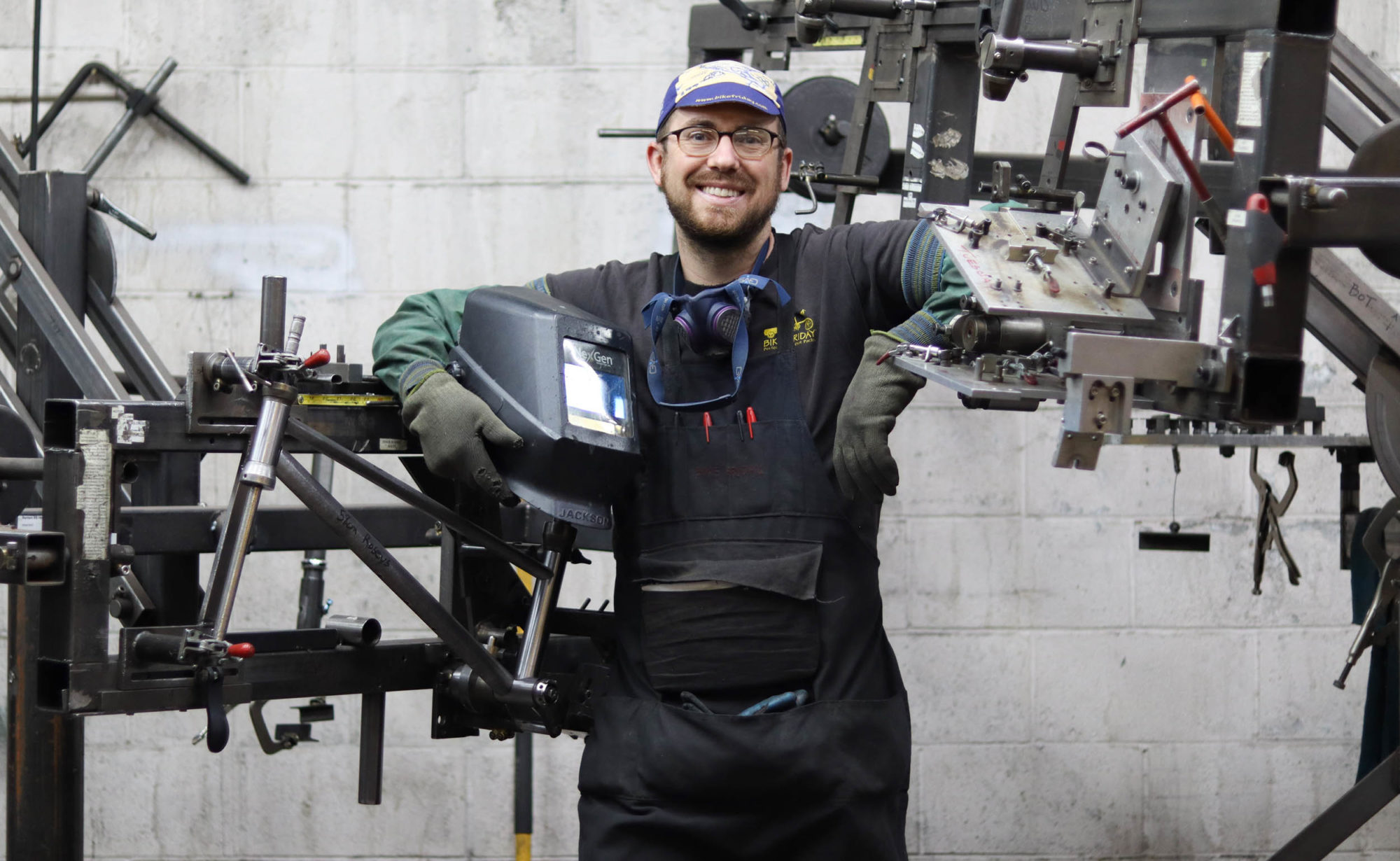
What’s your background in engineering and building, what kind of bike projects are you most excited about, and what kind of cycling do you do?
My background is in bikes and boats. I grew up mountain biking the Ice Age Trail in the Kettle Moraine of Wisconsin. My degree is in naval architecture and marine engineering, and in college, my first fixed gear was a human-powered submarine! I’ve worked at a few shops, but mostly focused on volunteering for community bike projects. I rode fixed for years but left the scene when all my friends started freestyling and playing polo more than riding hard (no shade, I just have terrible coordination).
Breaking into the cycling industry was a struggle. For several years, I’d send out applications for every engineering or fabrication job that’d open in the industry, then go bike touring while I job hunted. I scratched the design itch with small projects like a folding hammock trailer and custom touring racks. In 2012, a bike tour took me through Eugene, Oregon, and I begged Bike Friday for an interview!
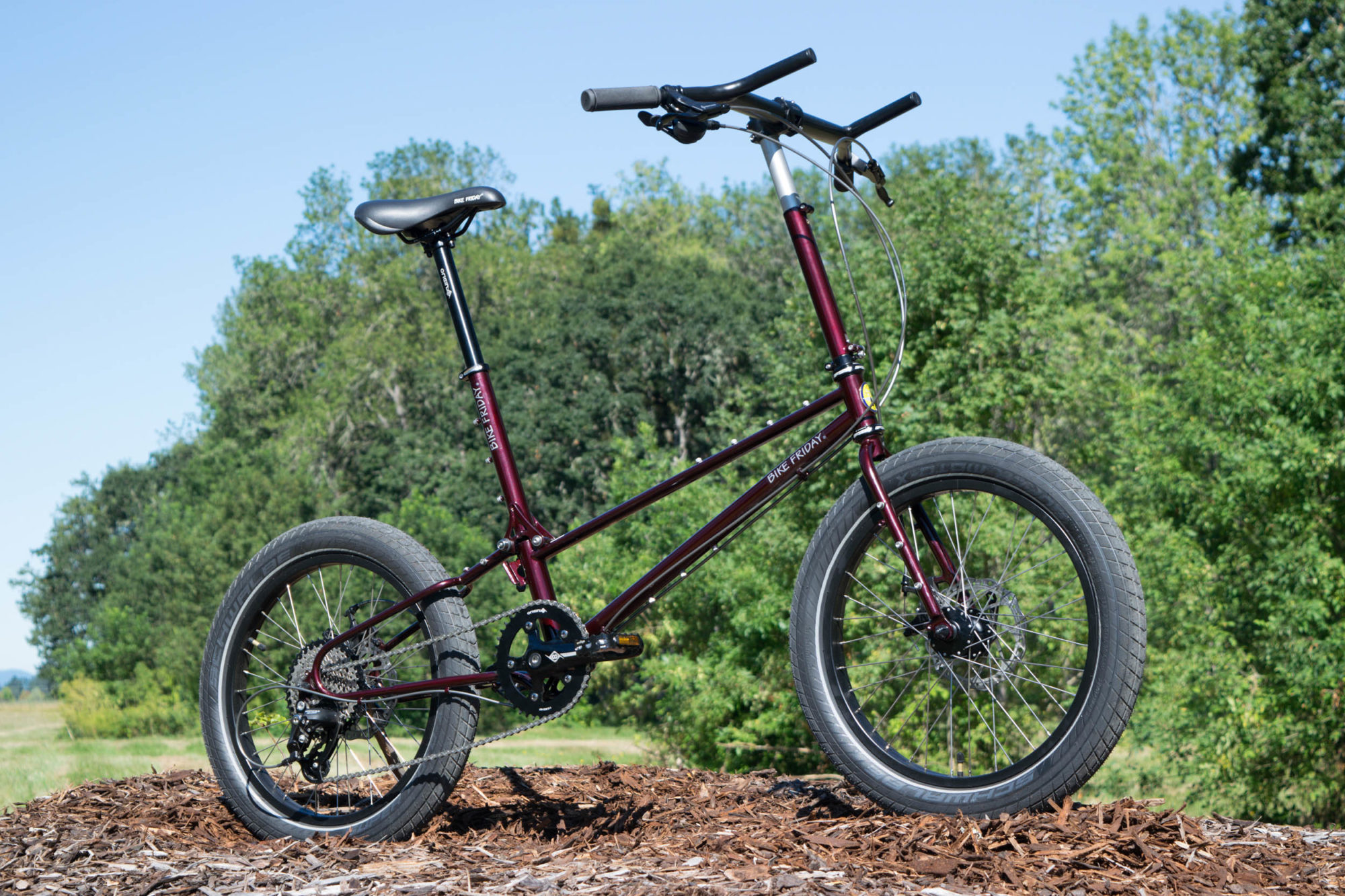
It turns out Bike Friday has a history of giving new people a shot at becoming framebuilders. But this isn’t UBI; I had 30 days to build my first bike from scratch, working for customers during the day and learning how to fillet braze, TIG weld, and powder coat at night. It was bike industry BootCamp, and it transformed my life. Other alumni include Rob of English Cycles and Eric of Winter Bicycles.
I most enjoy bike projects that start with unusual constraints, and through a creative optimization process, drive the design in unusual directions. For example, when entering a Kinetic Sculpture Race, I decided to aim for maximum artistic impact for minimum resources – so I ended up riding a nine-foot-tall T-Rex skeleton. “Sue” is a recumbent tadpole tall trike, weighs 90 pounds, cost $200, and is quite the attention grabber.
I’ve been car-free 12 years now, so most of my cycling is utilitarian. Exploring my neighborhood, town, and region is very important to me, so I’m often out on long weekend rambles. I love racing weird stuff, so cargo bike racing is also a bit of an obsession. Oh yeah, and I bikepack!
For the readers who don’t necessarily know Bike Friday and that it’s celebrating its 30th anniversary this year, could you tell us about it?
We are around 20 people in Eugene, Oregon, lean manufacturing custom bicycles. Bike Friday is what you get when two talented and principle-driven brothers, Alan and Hanz, are busy building bikes in the early 90s and they pay attention to the customers asking for a bike that makes traveling easier. Throughout our history, we’ve made dozens of innovative designs, including recumbents, Ti-beam travel bikes, even folding bikes that are the lightest (13 pounds) or with the fastest fold (less than three seconds) in the world. Now, our range has expanded beyond folding bikes to include tandems, cargo, and e-bikes. Bike Fridays have small wheels, and some fold, so folks compare us to other folding bike makers. But as a business, Bike Friday has more in common with other established US custom bike makers like Waterford, Independent Fabrication, or Co-Motion. We are still family-owned and operated, now by Alan’s daughter Hanna as president.
Tell us about the idea behind the All-Packa and its development.
In 2020, I started a program of research and development (AKA tinkering) with the high aim of creating the ultimate bikerafting bike. The code name was Tardigrade (AKA Water Bear). As I tested prototypes, I realized that Bike Friday might be able to provide something more broadly useful to bikepackers. There was a gap in the “travel-friendliness” of bikes for bikepacking between 29ers and something like the Brompton.
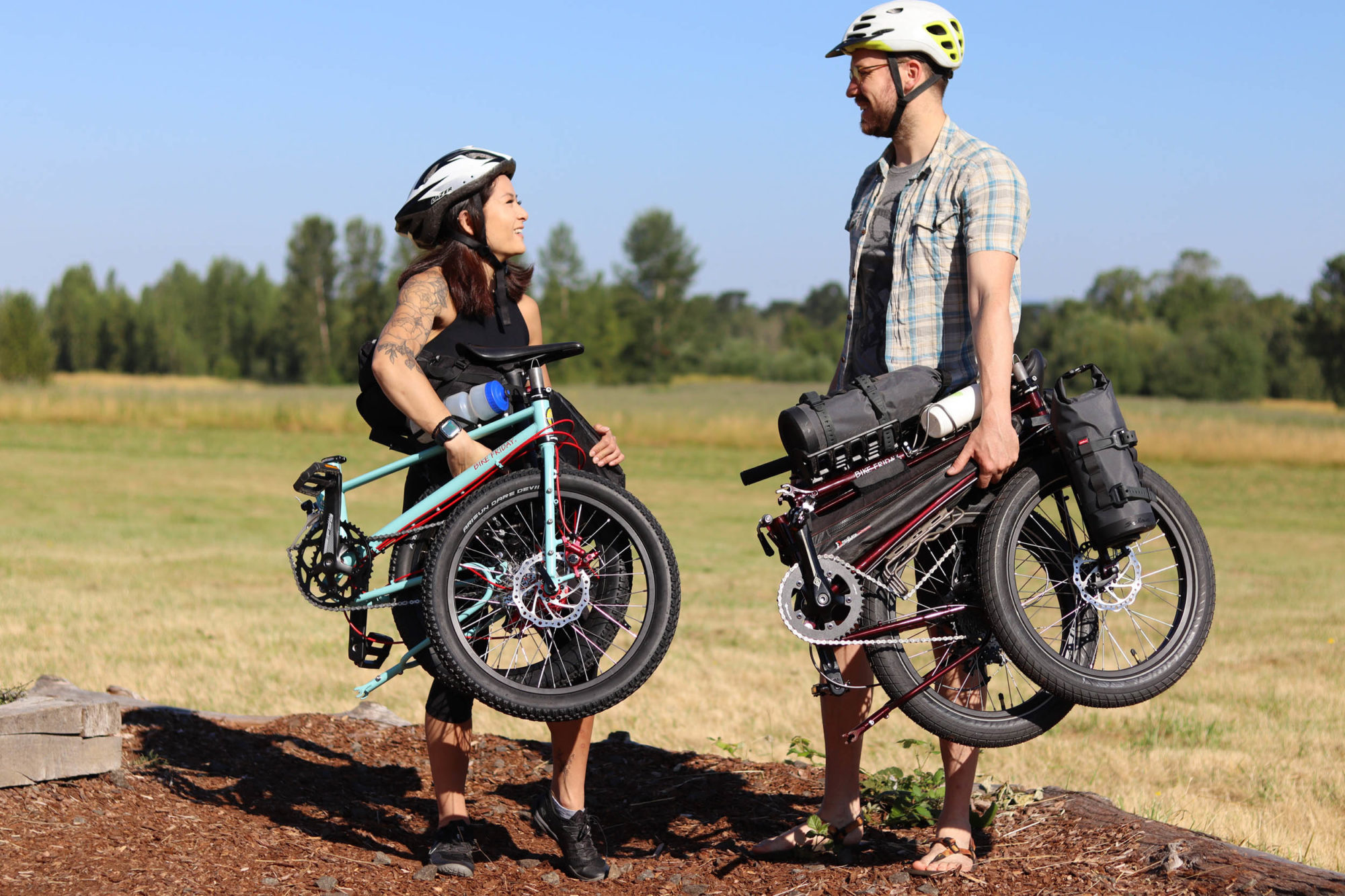
It’s the rare bikepacking route that is unpaved right from your front door. Our transportation network in the USA is car-centric and sometimes challenging to navigate with a loaded rig. The All-Packa allows more flexibility and ease in how you create your adventures. I’ve endeavored to design a bike that makes both the journey to the ride and the ride itself more accessible to more people. One benefit is how you can more easily choose to integrate less impactful forms of transportation like buses, trains, and ride-sharing into your cycling. Another important idea behind the All-Packa is the improved fit, gear capacity, weight, and ride quality for smaller riders because of the 20” wheel form factor. And every Bike Friday owner knows how well our bikes work as conversation starters!
Say more about the bikepacking potential of the All-Packa.
Here in Eugene, we have buses that go 60 miles to the coast or up into the mountains. The buses can hold a few bikes, but on busy weekends, they can fill up and then you have to wait with your bike for the next bus. The buses always let on folded bikes. With the All-Packa, I have easy access without a car to overnighters along the ACA Pacific Coast route, the McKenzie River Trail, the Oregon Timber Trail, etc.
An example from the East Coast: Fly into one of the major cities without a bike bag fee. Urban exploration is easier as you can bring your bike and gear inside into hostels, museums, and such. Then hop on the subway to the train station, and get out to upstate NY or Pennsylvania with you and your bike together in the railcar with no special bike reservations or limits on how many bicycles are on that train. If there’s weather, the bike can tuck under a tarp or tent vestibule and stay lubed and dry. If something goes wrong, you can hitch a lift in a compact car. Maybe you want to incorporate a rafting trip? Fold and go! And along the whole way, you can continue to enjoy the same routes and riding you’d be doing on your normal bikepacking bike.
The best bike is the bike you have with you. If your bike fits into the rest of your life and travels more easily, then you get to ride more. It’s so simple and so powerful.
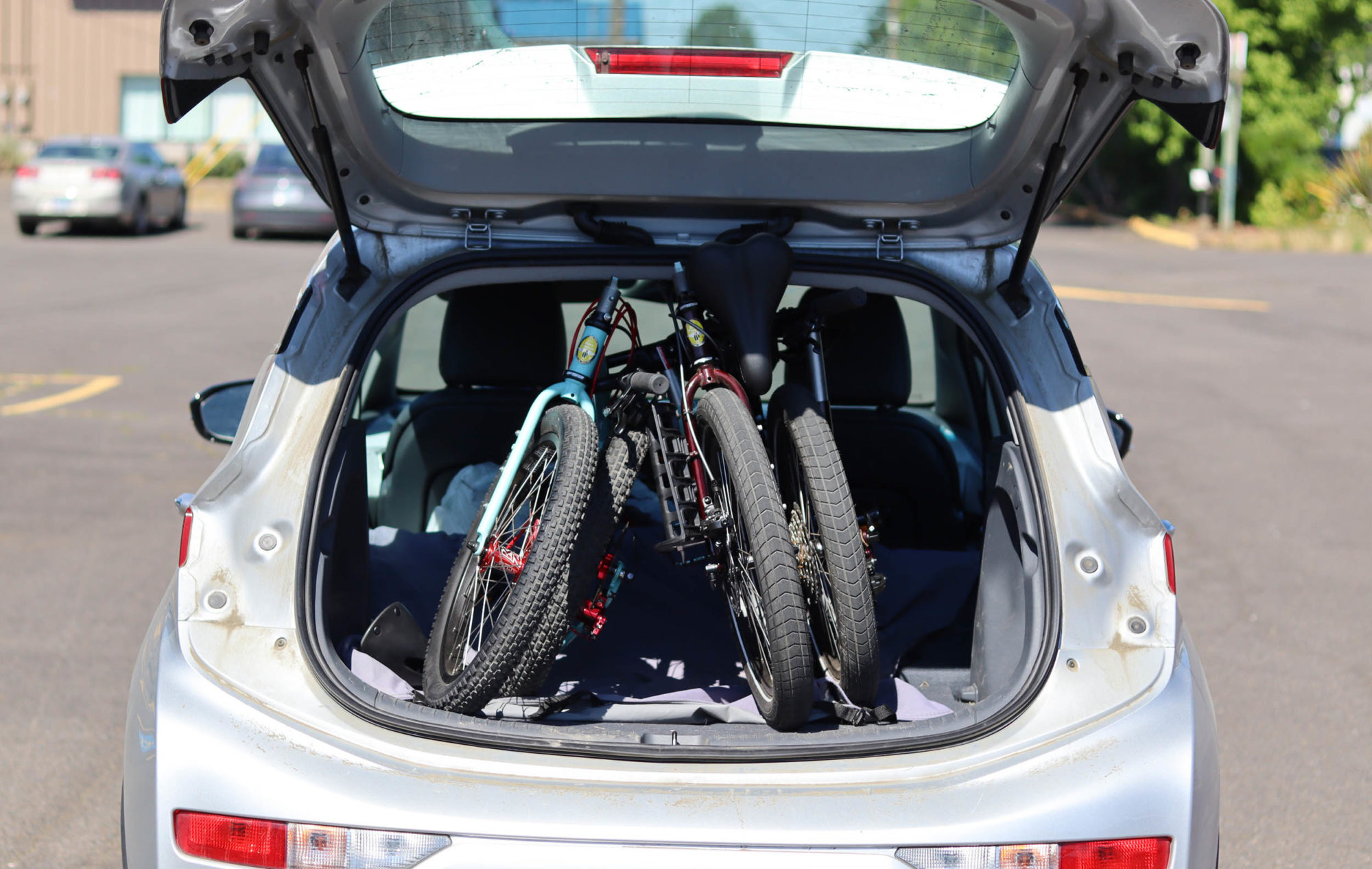
Recently, two friends and I wanted to head to a trail system 30 miles away. My friend has a tiny hatchback that holds only two bikes on the roof. There just wasn’t room for a third full-size bike without stripping to the bare frame. If I’d had an S&S coupled travel bike, I could have broken it down enough to fit in the back in 5-10 minutes. With a Bike Friday travel bike, it only takes 15 seconds to quick fold the bike. I folded my All-Packa, popped it in the back, and we all rode the trails together.
What sort of ride feel were you going for? How did you achieve it?
Think “capable gravel bike.” Or “wow, this does not ride like a folding bike.” Or “Am I riding a ’90s rigid mountain bike right now?” I’m trying to maximize the capability and enjoyability of the bike, with a clear-eyed acknowledgement that wheel size does affect how a bike handles different terrain. Smaller 20” wheels are lighter, stronger, and lower-inertia (more nimble and faster accelerating) than 29er wheels, but they struggle when they have to roll over larger obstacles. So, 20” is to 29er as 29er is to 36er in terms of being able to steam-roll over stuff.
Geometry wise, most Bike Fridays are based around classic road touring geometry, with the rider touch points, BB position, tire contact points, etc., all matching a conventional bike. For the All-Packa, I stretched the wheelbase, lengthened the front-center, steepened the effective seat tube angle, and increased the BB drop to optimize BB height for load-carrying on 2-2.4” tires. If that sounds similar to modern mountain bike geometry, well, that is not a coincidence, but how I went about it is rather different.
In our conversations, you’ve emphasized that working on folding bicycles presents many more design constraints than on a non-folding bike. What are some of the challenges of creating a bikepacking Bike Friday?
If your rear derailleur is contacting your front disc caliper on a non-folding bike, you’ve got problems. On a Bike Friday, that’s just one example of the complicated interplay of offering custom sizing, compatibility with standard components, and a bike that folds. Another: we’d love to offer more tire clearance, but then we’d have to shift to Boost spacing, which doesn’t pack in a suitcase. As a general rule, I’ve kept to road/gravel standards over MTB because mtb standards have ballooned over the years and are unwieldy for travel.
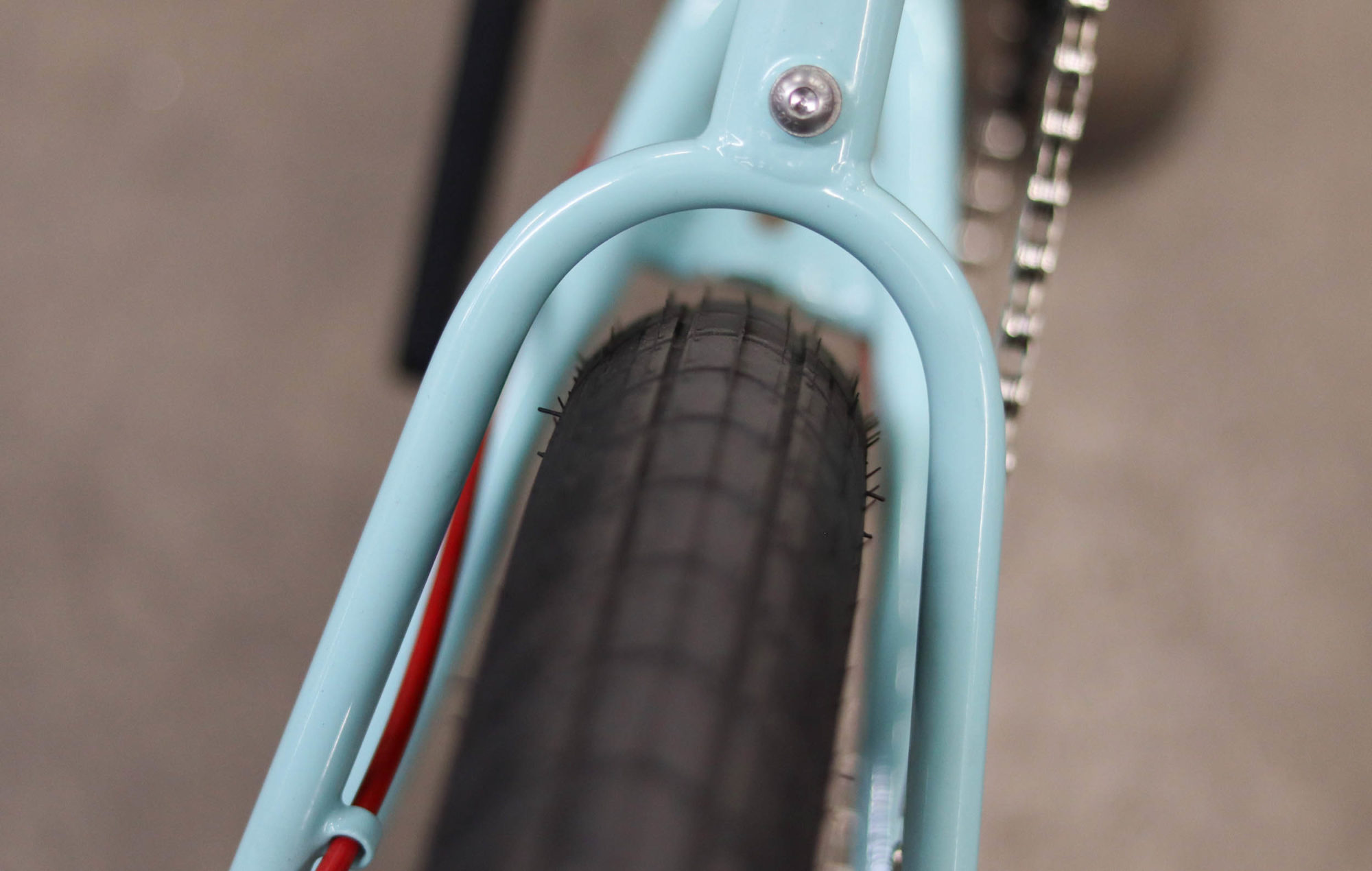
I also experimented with frame geometry to work within the constraints of a folding bike to improve handling on rough terrain. I tested head tube angles from 69-73 degrees and seat tube angles from 71-78 degrees. I wanted to achieve the excellent handling of 29er bikepacking bikes, but I found a few issues. Modern mountain bikes have very different head and seat tube angles from each other. For frame design, this means that the top tube length is dependent on the height of the head tube, i.e., the fork length. The head tube is much lower on a Bike Friday than a 29er to achieve the other functions of folding and packing into a suitcase. This large difference in head tube locations means that trying to match rider position and angles of a 29er would make it impossible to have the Bike Friday fit a taller person. To fit a 6’/183cm person with 29er angles on a Bike Friday frame would require a 100cm top tube! That would not fit into a suitcase!
In the end, I am using a more gravel-oriented geometry and have kept the head and seat tube parallel at 72.5 degrees. For improved all-terrain handling, I get the front wheel forward and achieve a longer front-center and wheelbase by using a 35mm stem and specifying swept-back bars. Using a zero-setback seatpost steepens the seat tube angle slightly to better keep the rider’s weight balanced between the wheel while climbing. I’ve rewritten the sizing algorithm that we use internally to ensure we can apply this new geometry when we are matching the fit of our customer’s other bikes. In practice, riders from 4’6″ to 5’10” (137cm to 178cm) will get an All-Packa with pretty remarkable off-road handling. Above 5’10”/178cm the frame will max out at 62cm and the handling will be more like our other models because the wheelbase can’t lengthen further and still pack in a suitcase.
Another important geometry change I’ve made is to lower the bottom bracket by 15mm. This is partially because the typical tires for this bike are 2.0-2.4” vs the 1.75” tires our other bikes are designed around, but mostly because I am prioritizing a lower center of gravity for better loaded handling over ground clearance over technical terrain. If you are riding gnarly rocks, ruts, and roots, I want you to slow down and watch for pedal strike slightly more than on a typical mountain bike. This keeps the riding safe and fun.
I tried front suspension but found that for 20” wheels, front suspension comes in only two varieties. One is low-quality stuff that only makes riding more difficult. The other type is built for kid’s mountain bike racing, which has low weight limits. So, nothing currently fits my quality or utility standards, and it doesn’t fit in a suitcase without pulling the fork.
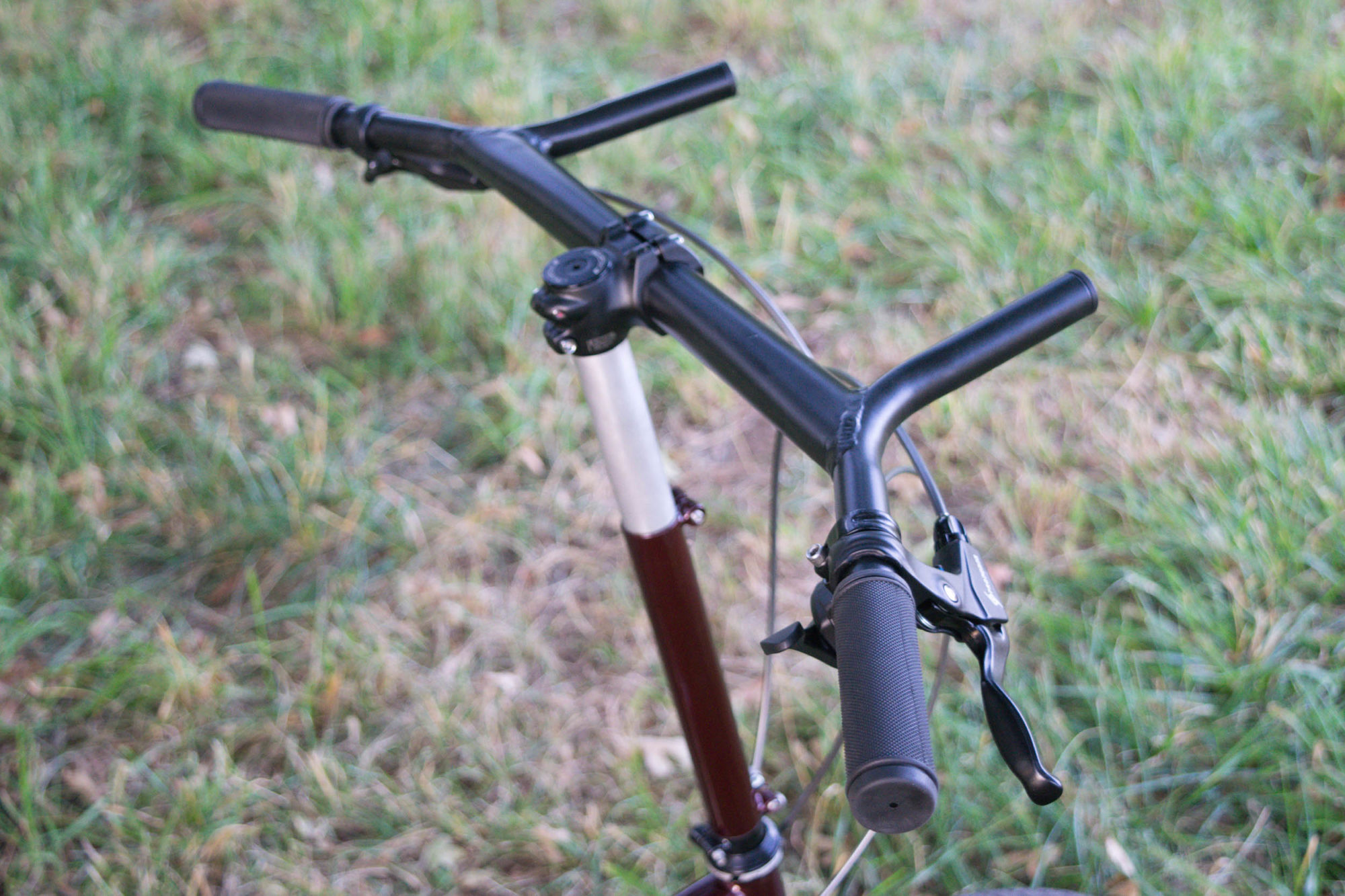
We developed our own bikepacking bar in-house because the wide, flared, or alt-bars that are so great while riding are very challenging to pack down. The Packalope bar has multiple hand positions and a few unique features: The big one is that it splits in half for easy packing. (Only when you want it to, of course!) We’ve been making a variety of split handlebars for decades and the system is very robust. The bar is also half the weight of its competitors because it’s segmented, which allows us to have more material in high-stress areas without weighing down the rest of the bar. The bar tops are flattened for improved palm comfort and to add some beneficial flex. Width is 730mm to accommodate smaller riders and because the lower-inertia steering of the All-Packa feels best with a narrower bar.
Bike Friday is proud of its circular economy, the fact that it does everything in-house, and the relative affordability of its bikes. Could you tell us about those aspects of the company?
We don’t believe in planned obsolescence. We want every bike we build to bring happiness to generations of cyclists. There’s enough disposable junk in the world. So we won’t incorporate new standards until we are confident the industry will support them for the long term. We have a very strong warranty and we stay in touch with our customers so they know we are there for them. If a frame wears out, we can repaint, repair, or replace it. If a frame is truly knackered, we recycle it. We’ve been doing this for 30 years and see this as our responsibility as ethical framebuilders and business people.
As for doing everything in-house, it’s a fairly simple decision, primarily driven by our unique solution to the problem of traveling with your bike. Is there an off-the-shelf solution for our unique problem? Often not. Can we create a better solution in-house? Sometimes yes. Can we more reliably produce on-time than other vendors? We find that frequently we can, and this was confirmed during the pandemic.
I believe that Bike Friday is the most affordable custom bike builder in the USA. While the economics of the bike industry make it difficult, we strive to make our bikes available at a range of price points. As a framebuilder, it’s fun to make the super boutique stuff, but those aren’t the only cyclists I want to serve. Every cyclist deserves a well-fitting, convenient, high-performance bicycle.
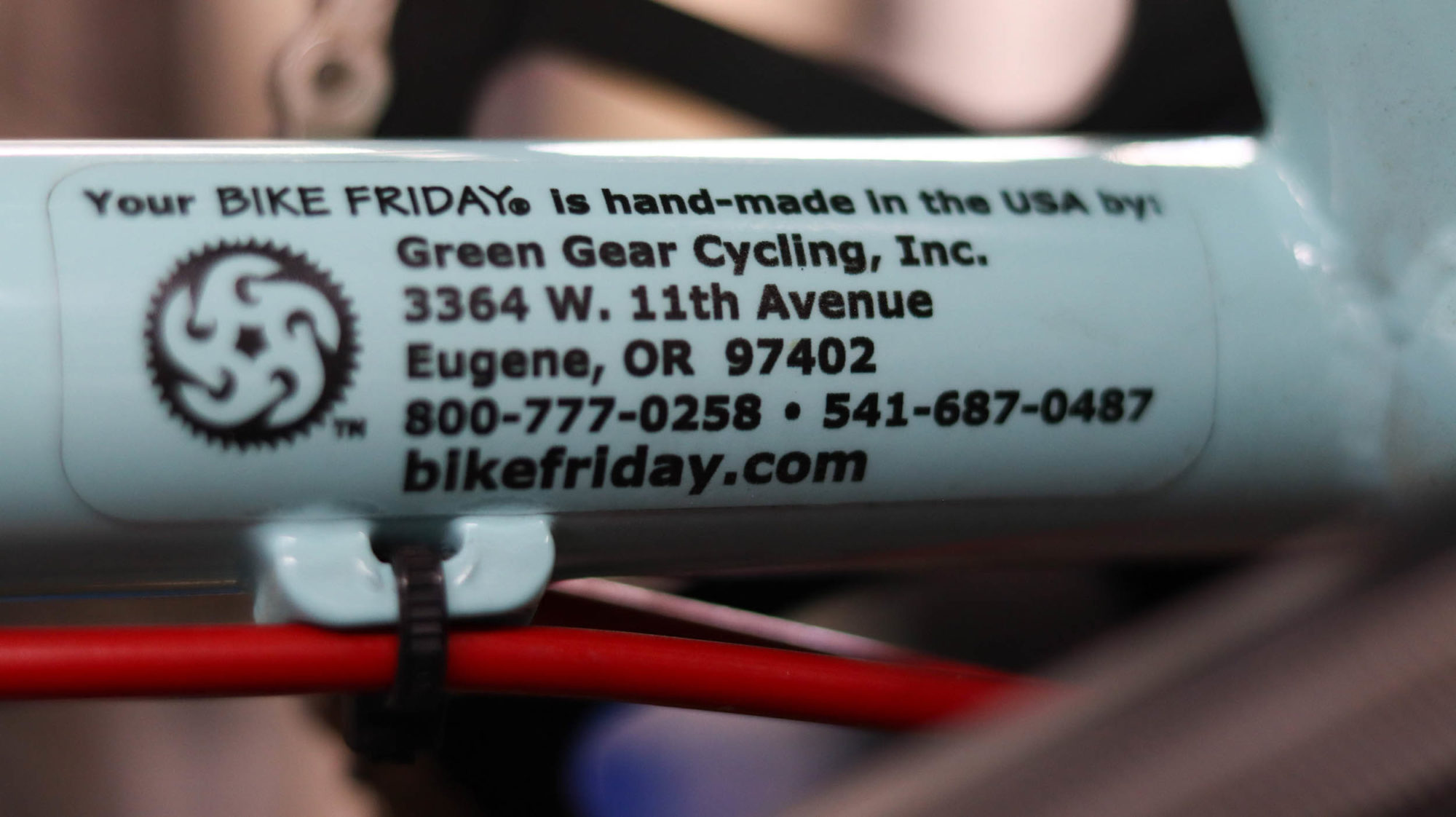
The bikes we are sending to BIKEPACKING.com for review reflect this. Unlike other brands, we are sending lower-spec components with a nice custom frame. Any bike rides better with fancy components, but that’s not the bike that the majority of people will be buying. I want people to see that the All-Packa can be a capable bikepacking bike, made in the USA, without breaking the bank.
What kind of rider and what kind of riding will the All-Packa be ideal for?
Not me, haha. Seriously though, I’m a 6’1”/185cm cis white male who is used to having every bike designed around me. I love my All-Packa but I’m on the big side of the sizing range. The smaller wheels, lower step-over height, and ride quality are optimized for smaller riders. If you are 4’6” to 5’10” (137cm to 178cm), you will be amazed at how much easier to handle this bike is compared to other rigs. The clearance for large handlebar and seat bags alone is a gamechanger. I recommend a weight limit of 220 pounds/100 kilograms, not because of strength issues, but because I’ve selected the tubing to keep a lively steel ride quality for lighter riders. There is no limit on gear weight.
To sum up the All-Packa’s ideal kind of riding in one word: gravel. A few more: doubletrack, logging roads, dirt roads, farm roads, jeep trail, even flowy singletrack. That’s not every possible bikepackable surface, but I think it includes many incredible routes all over the world, and with the All-Packa, those routes are easier to get to than ever.
Is there anything else you would like to share about Bike Friday or the All-Packa with our readers?
I want to share my intention to listen to the feedback of the community and continuously improve the All-Packa for riders. The sharing of talent, perspective, and experience from so many other bikepackers has been a huge inspiration over the years, and I hope that the All-Packa can be my collaborative contribution to the bikepacking movement.
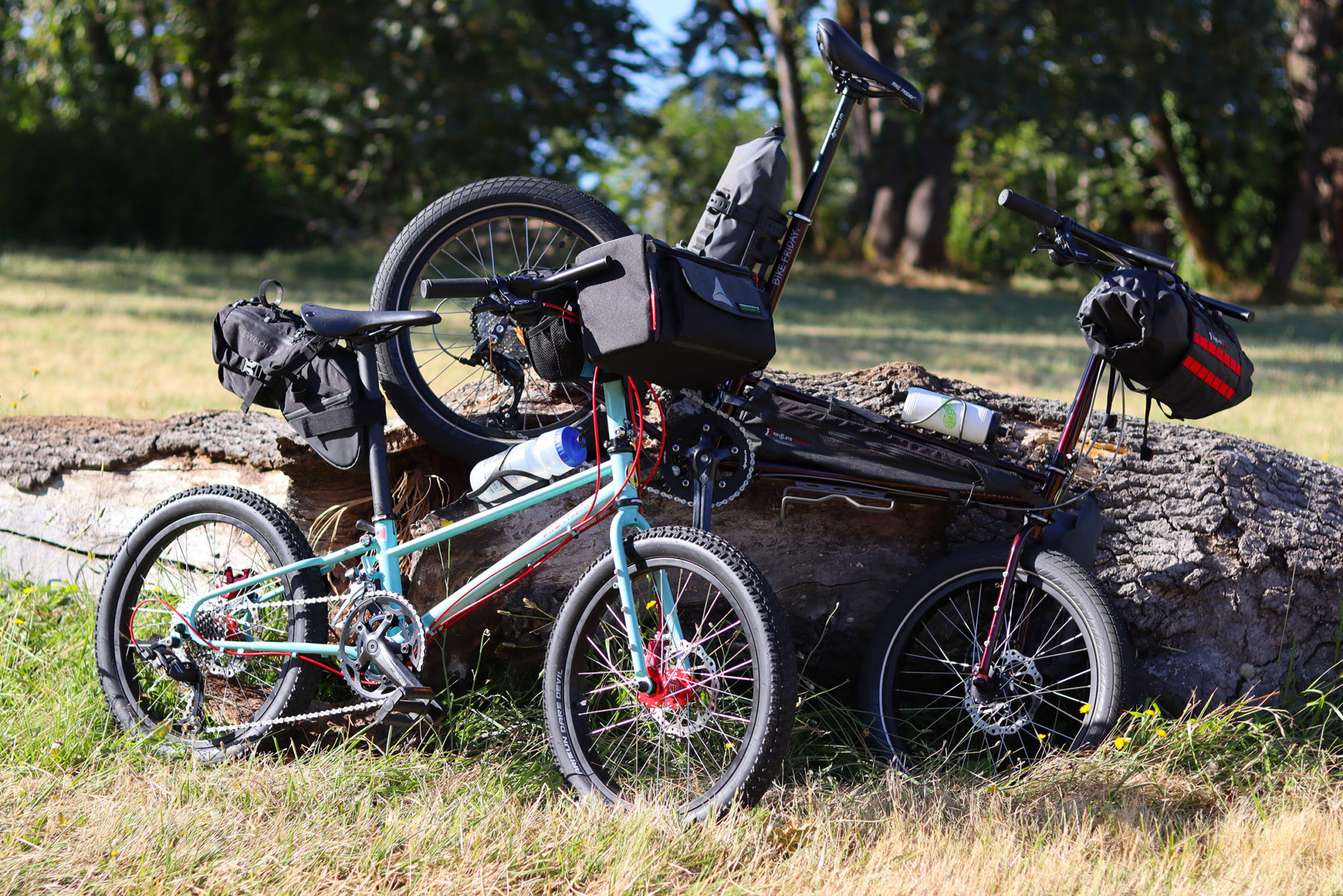
The All-Packa is available now for order with delivery in October 2022 for the finished bike. Frame kits start at $1,595. The basic builds start at $2,495 with opportunities to customize and upgrade parts selection. Head over to BikeFriday.com to learn more and contact Bike Friday sales@bikefriday.com to discuss.
Please keep the conversation civil, constructive, and inclusive, or your comment will be removed.







